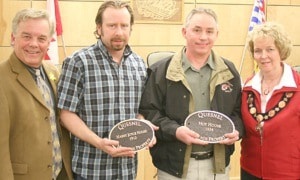In 2010 the City initiated the Heritage Plaque program recognizing properties which are deserving of particular recognition due to their historical or architectural significance, their state of preservation and their contribution to the streetscape.
Dr. Allan Baker, owner of the Hoy House and Douglas Smith, who owns the Harry Joyce House, were presented with small bronze plaques bearing the name of the building, the date of construction and the designation “Quesnel Heritage Property,” by the Mayor and Council in April.
The plaques are to be displayed on the outside of the homes, visible from the street.
The properties were selected by members of the citizen’s advisory committee who helped develop the Quesnel Heritage Register. They join six other properties previously awarded plaques.
Harry Joyce House
The Harry Joyce House, located at 558 Front Street, was built in 1910. Harry Joyce was born in Wales in 1876 and came to Canada as a child. He apprenticed as a carpenter joiner and served with the Strathcona Horse in the Boer War before settling in Quesnel in 1907.
He soon established himself as the principle builder and contractor in the community and also oversaw projects in Barkerville, Wells, Alexandria, Williams Lake and Vancouver. Joyce operated a sawmill which provided the wood for many of his building projects. In 1910 he married Clara Baker, the daughter of the early settlers of West Quesnel, August and Cecilia Baker and built his family home on Front Street.
Joyce built or renovated most of the prominent buildings constructed in the community from the time he arrived until his death in 1938. These included the Occidental Hotel and John A Fraser’s store on Front Street, both destroyed by the 1916 fire, the Mission House for the Anglican Church (built in 1912 and destroyed by fire in 1923) the Court House (built in 1913 and demolished in 1963) and the Legion (built 1934 destroyed by fire in 1995). He not only built the first curling rink, but, due to a lucky win in an Army and Navy Sweepstake, lent the money for its construction.
Very few of the structures built by Harry Joyce have survived to the present. Three notable exceptions are St Andrew’s United Church, the Hoy House and his own home.
Therefore, the house is significant as a rare surviving example of the workmanship of this prominent and prolific builder. It has undergone very little alteration since the death of Harry Joyce apart from a small, window-filled addition at the front of the house, built in 1952 as a dental office for his son-in-law Dr L. W. King. Joyce’s widow, Clara continued to live there until 1970. The historical integrity of its present state adds to its significance.
Finally, due to its location across from Quesnel’s hospital, Clara frequently took in expectant women, who lived outside of Quesnel, when they were close to their delivery date. The house therefore has personal associations for many members of the community.
Hoy House
The Hoy House, located at 283 Barlow Avenue was built in 1934 by prominent businessman Chow Ding Hoy, to accommodate his growing family.
C.D. Hoy arrived in Canada from Guangdong, China in 1902, at the age of 19. His father borrowed money for his fare and the head tax. Hoy worked at a variety of jobs, saving money to send to his family before returning, briefly, to China to marry.
In 1913 he purchased a barn and log buildings on Barlow Avenue in Quesnel and opened his general store. Over the years, Hoy operated a number of businesses from this location, including a restaurant, boarding house and photography business, but as the general store prospered he phased out the other enterprises. In 1917 his wife, Lim Foon Hai, joined him and within a year their first child arrived. They eventually had 12 children, 10 girls and two boys.
The house which C.D. Hoy built in 1934 is a testament to his hard work and success in Canada.
It’s a large one-and-a-half storey wood frame house with a full cellar, nine-foot ceilings and wood paneling on the ground floor and all the modern amenities including two bathrooms and electric lighting.
It was the first stucco building in town, decorated in three shades using crushed red rock from Red Bluff and ground ginger ale and beer bottles.
The fact that such a house could be constructed in 1934 indicates that Quesnel did not suffer as severe a depression as some other regions, in large measure due to the operation of the Cariboo Gold Quartz Mining Company in Wells. It is now one of the few surviving buildings constructed by Harry Joyce and is a fine example of his workmanship.
During his lifetime C.D. Hoy was acknowledged as one of the most successful businessmen in Quesnel. In more recent years he has been celebrated for his talent as a photographer.
The remarkable portraits that he took in Barkerville and in his early years in Quesnel have been preserved and provide us and future generations with a glimpse of life in the Cariboo at the turn of the 20th century. Furthermore, life in the house that Hoy built has been delightfully captured by his daughter, Lily Hoy Price in I am Full Moon.
The building has been selected to receive a heritage plaque this year to acknowledge the recent renovations which removed some of the later additions made to adapt the building for use as a restaurant. It’s reassuring to see a vacant heritage building of such significance being renovated and put back into use.
